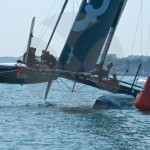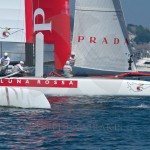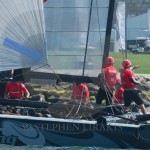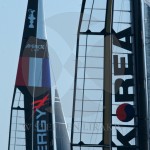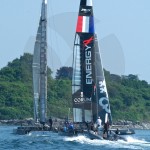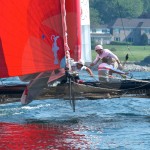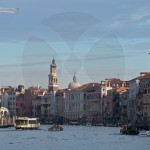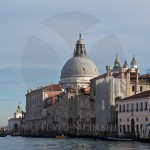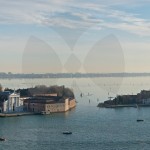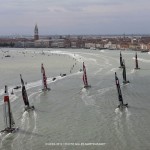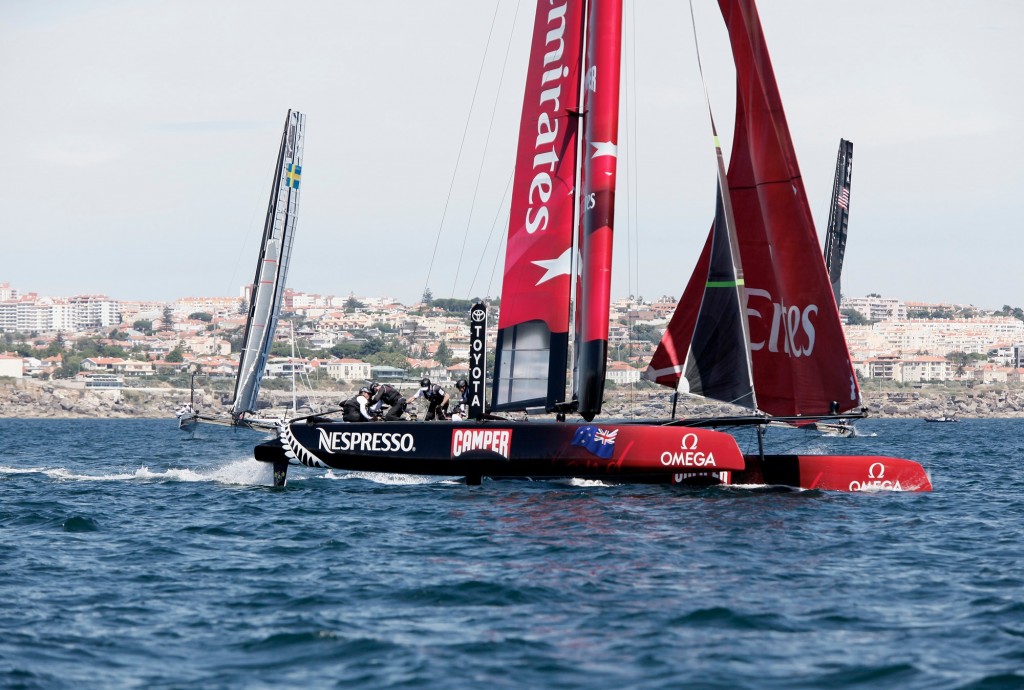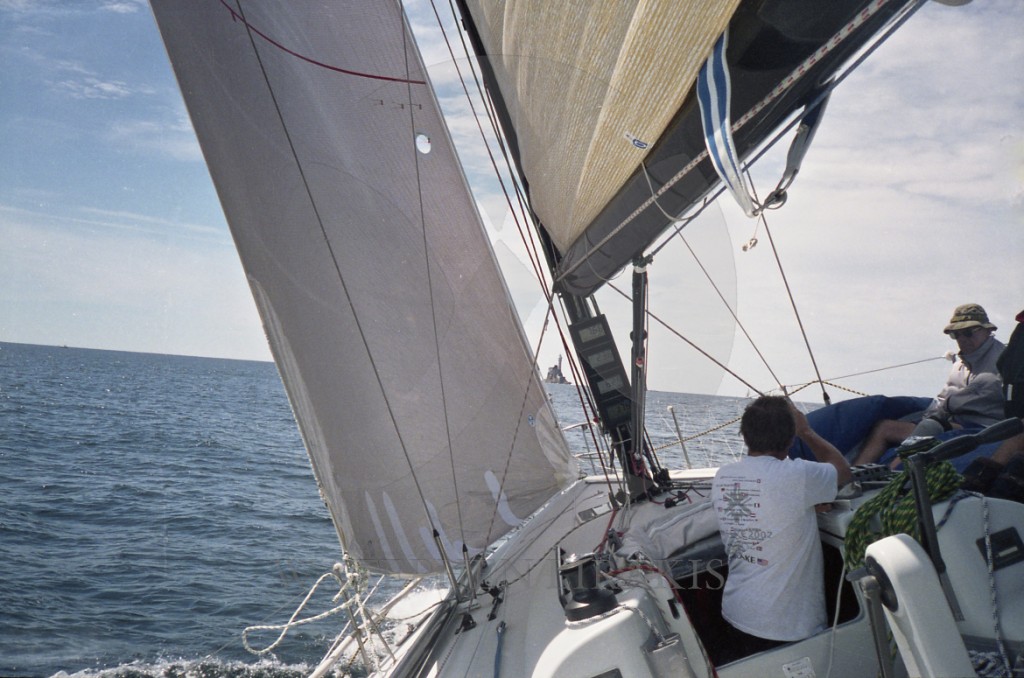Dean Barker is someone, while I do not know him strikes me as a really solid sailor, with his head squarely on his shoulders, so when he speaks on the subject of the America’s Cup I am inclined to listen.
SUNDAY, OCTOBER 16, 2011
Dean Barker: “We’re about winning the America’s Cup”38-year old skipper Dean Barker and his team Emirates Team New Zealand (ETNZ) currently sit at the top of the leaderboard of the America’s Cup World Series Championship with 38 points (19 scored in match racing, 19 in fleet racing), just four points ahead of Oracle Racing Spithill. With the third and final World Series event for 2011 just around the corner, Barker updated Sailblast on ETNZs training progress…as well as shared some thoughts on the new AC game…
What was one thing that you took away from racing AC45s in the recent in events in Cascais & Plymouth?
The biggest eye opener is the maneuverability and how the racecourse and boundaries operate. It makes the racing just so much tighter and more emphasis on crew work and boat handling than ever before.
Emirates Team NZ (ETNZ) did extremely well – what do you attribute your strength to this early in the game?
We were really happy with our performance. We know we can sail a hell of a lot better but I’m sure like all the teams you make a lot of mistakes around the course but it’s a challenge with these boats in tough conditions and close quarters with other teams. It’s going to be hard to sail at a high level.
We’ve put a lot of effort into our crew work and boat handling and that’s paid dividends. I think during the period in Auckland we’re a bit off the pace. At our first crack at the soft sails, they were good but not good enough so we’ve developed our sails – we’re into our second generation and that’s been a big improvement in our speed. We feel like we’re a lot more competitive now against Oracle who in Auckland who had quite a big jump it felt over the rest of us. We’ve made some good gains there. But we’ve worked really hard on things like getting around the corners and being able to react in all different situations around the course. That’s been a big strength.
How are you preparing for San Diego?
To be honest we’ve been pretty full on working with boat design for the 72. San Diego is rolling around pretty quickly so we will need to get our heads back in the game for racing but we have a few practice days there before racing proper starts so that’ll give us an opportunity to get back into it all. We’ve been doing a bit of sailing back here in Auckland on the 33s as obviously like everyone else, except Oracle who have a couple of extras, our 45 is en route to San Diego.
How’s the transition to the multihull been for you?
I’ve been sailing multis now for a year and it’s amazing. It feels like the progress that we’ve made since we came last in Almeria in the Extreme Series last year. It feels like we’re making some really good progress. I’d say it’s still not necessarily instinctive like monohull sailing was. There’re times when you know what you want to do but you can’t quite make it happen instinctively. But it’s coming – it just takes time to reprogram yourself to adjust to different situations where things happen very very quickly. You have to be able to make decisions a lot quicker than in the monos. But it’s all a really good challenge.
Who is your back-up skipper?
We’re a pretty small sailing team at the moment. We really don’t have a lot of back-ups in any position to be honest! Depending on who is injured at any time we’ve got cover by three grinders and a few others who aren’t sailing on the boat.
When will ETNZ expand its sailing team?
That’s about it really. We’re not going to have two 72s. We just don’t have the resources to do it. It’s too expensive to take two 72s off the dock and go two-boat testing. It’s an expensive game we’re in and to take two 72s sailing, you’d need an army of people. There’s probably only one team that’s in that position right now.
Where are you at in the 72 design/build process?
We’re in the final stages of our design. What we’re learning pretty quickly is that the more you learn the more you don’t know! You just have to try to narrow in on the first design. The good thing is that we’re making good progress, the hard thing to know is what is the level you’ll need to be at in 2013. The learning curve makes it seem like we’ve got a long way to go but we’re at a level where we think we’ll be competitive enough. We have a design group of about 30 people we draw from including Pete Melvin, Scott Graham, Luc Du Bois – there’s a bunch of guys who are contributing. Cookson’s will build the hull and structures, and Southern will build a lot of our wing and wing components.
Who is developing your sails/sailplan?
We’ve done most of sail development in-house so far. We get a lot of input off the chase (boat) and evaluate our sails against where the opposition is. Oracle is by far the most experienced in these boats and have sailed them more than everybody else and have probably built more sails than the rest of us. You’re always looking to measure yourself against where they’re at and the direction they’re going. But, we’re pretty happy with the choices and development we’ve made.
What are some things you can see from the 45 that will translate to the 72?
The 45 is a nicely balanced boat, it’s fun to sail, it’s relatively easy to sail compared to the more traditional X-40 type designs, it’s quite a robust boat and seems to perform well across a variety of conditions. We’ve learned a lot just from sailing that but it is limited in a lot of ways. It’s got straight boards, it doesn’t have any real lifting component, it gets limited by wind speed, it’s a bit hard to push up the range but it’s a fantastic boat for learning about multi hull and sailing with a wing.
The 72 is a hugely more powerful boat. When you scale the 45 up to a 72 boat, it’s quite underpowered. The challenges that are going to go with the size of the 72 are pretty daunting. The boats in a strong breeze are going to be animals. They’ll be very hard to sail in SF conditions and you’ll certainly have to have your wits about you to get around the course. They’ll have capability of very high speed and you’re going to have to be really in tune to sail with them well.
What’s different about this Cup Campaign for ETNZ?
Apart from the obvious, lifestyle and scenery, it’s adapting to a different world. We’ve moved from a world of detailing and fine tuning to one of complete new world of open book, fresh paper design. Any ideas are certainly worth consideration. There are no stupid questions or ideas right now. With this multihull world, we’re just scratching the surface of a huge unchartered territory. It’s not even like a new design rule within the monohull environment.
Do you think it was entirely necessary to move up to the 72 for the real deal in 2013, or do you think a successful Cup could be staged in the 45?
Well, the 45 would really detract from what the essence of what the America’s Cup is about. It has always been a design race. I think to take away that aspect of the Cup would be a tragedy. It’s about managing so many different aspects of a campaign for a successful America’s Cup. When you get it right, then rightfully you deserve to win the America’s Cup. From a sailor’s point of view, one design racing is great because in the end the best team wins. There’s no argument about who had the better boat. It comes down to who sailed the best. So, there’s two schools of thought but in some ways I still believe in the traditional values of the Cup. It’s about managing a whole lot of different aspects: design, sailing team, campaign management and just getting to the start line. I still think it’s the right move that we’re racing in a development boat in the America’s Cup.
If Oracle was so committed to keeping costs down for AC34, how could they then go buy four AC45s while the other teams have only one? What’s ETNZ’s position on this?
There’s no way Oracle is committed to keeping costs down. It’s a complete fallacy that they’re trying to keep costs down. It’s absolute bullshit. The whole idea of this next America’s Cup was to try to make it more affordable for the teams. I can tell you right now that the budget for doing this campaign is at least what we spent last time and you can do it for less but you just don’t have a chance to perform. It’s a complete joke if they can sit back and say it costs less money, it’s not. It’s way more expensive. But that’s the game we’re in. If you want a crack at winning the America’s Cup you have to play by the rules and these rules are more expensive.
* Ed’s note: America’s Cup Race Management (ACRM) does not limit the teams’ training outside of World Series events, for instance, some teams will sail as soon as boats are off the ship in San Diego and others will opt not to sail until closer to the start of racing. And, any team can purchase an additional AC45 for training…assuming that they can afford to.
If ETNZ knew what it knows now before you signed up, do you think you guys may have given this next one a miss?
Definitely not. Emirates Team NZ exists for the America’s Cup and we’ve weathered the storm since 2007 to give ourselves the opportunity to compete in the 2013 event. You can’t afford to sit out, it’s just too hard to come in green and expect to get straight on the pace. If you miss a cycle, with all the development you’ll never catch it back up. It’s too much time. We decided that whatever the direction the Cup took that we’d contemplate it seriously, evaluate whether we could raise the money and give it a really good go at winning it. We’re not it in to make up the numbers, we’ve only entered because we think we can put up a challenge with a team that’s good enough to win. Time will tell if that’s the case. But, we’re a team that’s about winning the America’s Cup.
Much of the excitement over the 45, particularly for the non-sailing fan, is thanks to the crash factor. We wont (hopefully) see that with the 72. Without the crashes do you think the event will remain interesting for the non-sailor?
There’ll be an element who tune in to just watch the crashes, looking for the capsize or the collision. Those people you’ll try to capture – you have to accept that there’ll be that element. Hopefully people will be interested in watching the racing for what it is as well and we’ll be able to capture a new interested audience. In the short-term while there’s still a lot of spectacular action that’s going to motivate people to watch. It’s no different to the X-40s – the biggest hits come with the best action.
Do you think a nationality rule would help the AC grow as a fan sport?
I think it helps countries identify with their teams. We’ve got other nationalities involved in our team but it’s still pretty much all NZ, which certainly helps our fan base within NZ and the support we get as opposed to some of the other teams. Even though they may represent the US, Sweden and so on, they’re not true national teams to the degree we are.
How does your family take your busy lifestyle?
Fortunately my wife Mandy is really good with it all because I’m a bit of an absentee dad at times. I have four kids – 3 girls and a boy between six and one. It’s a lot of fun, never a dull moment. You feel like you leave one circus and go home to another one!
What’s your other business and how do you find time for that while still running a top AC team?
My primary focus is with the team so I spend the majority of my time sailing and working with the design group when I’m not traveling to events. When I do have a little down time I try to keep up to speed with Kiwi Yachting Consultants, a company I’m involved with in NZ, and also Nexus Marine which marine electronics company in Sweden.
When do you expect to be moving full-time to SF?
As a team we wont go up to San Francisco – mainly because of cost – until April/May 2013 full-time. We’ll be there next year for the events in August and September which will be great. I’m absolutely looking forward to sailing on the Bay, I’ve done a little bit of sailing there but not much. It’ll be an amazing spectacle for sure.

